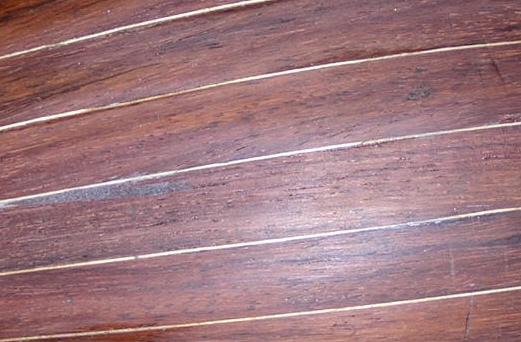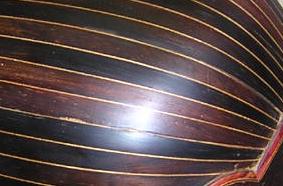French Polishing
- prepare the wood
- spit coating; (also called wash coating) optional, aimed at coating any purfling or inlay to stop colour 'bleeding' across to other surfaces during finishing. 3 coats.
- pore filling; (also called 'grain filling') aimed at creating a mirror flat surface on which to appy the shellac.
- apply shellac; (also called 'bodying') aimed at building up a coat of shellac thick enough to protect the wood. 6-8 bodying sessions.
- remove any oil; (also called 'clearing', 'stiffing' and 'spiriting off'.)
- rough levelling
- apply shellac; (also called 'bodying') second main application of shellac. 4-6 bodying sessions
- final levelling
- polish; (also called 'glazing')
- Spit-coating is done with a folded cloth, the shellac being 'wiped' on in straight lines. A piece of folded t-shirt material is ideal.
- Saturate the cloth but use NO oil or alcohol. Re-fold to present a clean face to the wood after each pass. When each face is used, a new piece will be needed.
- Once the first spit coat is completed, it should be repeated twice more, with a gap of about 30 minutes between coats to allow the shellac to dry.


- Method 1: one of the easiest ways is by dampening a pad with alcohol and sprinkling on some pumice powder. This is rubbed over the surface in small circles. The dust this creates fills the pores. If the wood feels smooth but the pores don't look filled, and no pumice is left on the pad, add more and continue. Keep checking visually. If you sand too much, long ridges of pumice and wood dust will build up, and then must sanded away. This is done BEFORE any spit coating.
- Method 2: (traditional French method) after coating the wood with a spit coat of shellac, saturate the muneca with alcohol, sprinkle a little pumice onto the pad and apply as you would the shellac, gradually covering the entire surface. The pumice thus fills the pores but leaves the surface very matt. With a clean muneca, once the pores seem filled, begin again with the shellac using a different pad. This is the method I use without too many problems.
- There are other methods that vary a little, some more complex, which I have omitted as more suited to furniture polishing.
- With a clean pad, add 2 lb cut shellac to the pad. Add about 12 drops onto the polishing surface. You will need less to re-charge the pad once it has been initially charged.
- Add a little alcohol to the pad, 6-8 drops. (Some expert say not to add ANY alcohol when bodying. Effectively you are thinning the shellac mixture, so it goes on thinner and takes more coats to build up any thickness. On the other hand, it goes on much more smoothly, and makes any levelling minimal. Your choice!!)
- Add a drop of oil to lubricate the pad. (Without the oil the pad will stick)
- Pat the pad on the back of your hand to spread the oil evenly.
- Apply the pad to the surface to be polished, moving in small circles or figures of 8. Apply and remove the pad from the surface whilst it is moving to avoid it sticking and leaving marks.
- As you rub, you should see a tell-tale opaque shellac 'cloud' following your pad. This quickly disappears as the alcohol evaporates. It is a good indication that you have the shellac-oil balance correct.
- As the pad dries, it will begin to be more difficult to move smoothly. Lift and add more alcohol and oil. Only add more shellac when you begin to lose your 'cloud'.
- Try not to re-cross recently shellaced areas, or you risk dragging partly set finish.
- Once the area is covered using a rotating pattern, change to straight firm passes. This will help keep the surface smooth.
- This is essentially the process.
- Repeat this 'bodying' 2 or 3 times, then finish by 'stiffing'. Using added alcohol ONLY and pressing firmly, make straight passes back and forth over the entire surface bodied.
- The instrument can be left to 'gas-out' for a couple of hours. This should allow any further oil to rise to the surface. If necessary repeat the 'stiffing'.
- Allow to set overnight before any more bodying is done. If done too soon, the top will dry first, and will 'craze' as the deeper layers dry.
- Using added alcohol ONLY, glide a folded pad on, and pressing firmly, make straight passes back and forth over the entire surface bodied. This should remove any excess oil. Some experts say that the shellac should be dried overnight before any 'clearing' is done.
- Keep checking the surface of the pad, and refold periodically to a clean surface.
- It may be necessary to 'body' and 'stiff' the instrument between 4 to 8 times before rough levelling.in order to build up a sufficient thickness of shellac.
- For rough levelling, use a rubber or cork- sanding block and 400 grit wet and dry and oil as a lubricant. Some soak the paper before-hand to make the paper backing soft.
- Wipe the area to be levelled with a light coat of oil, then sand with a circular motion until the area is totally smooth. On a bowl-back I tend to hold the paper in my hand.
- Too much oil and you will glide over the surface and do nothing; too little and the sandpaper will load with shellac.
- Wipe down the area to inspect your work, and when you are finished.
- If you sand through the finish at some points, it can be re-covered in the next bodying session.
- For final levelling, after another half a dozen or so bodying sessions, use a rubber or cork- sanding block and 800 grit wet and dry and oil as a lubricant.
- Using the 'bodying' muneca, charged fully with alcohol, but not dripping. No oil!!
- Work back and forth over the instrument in straight lines, with very firm pressure.
- The harder the pressure, the harder the surface will be.
A good article on French polishing furniture, another perspective: here